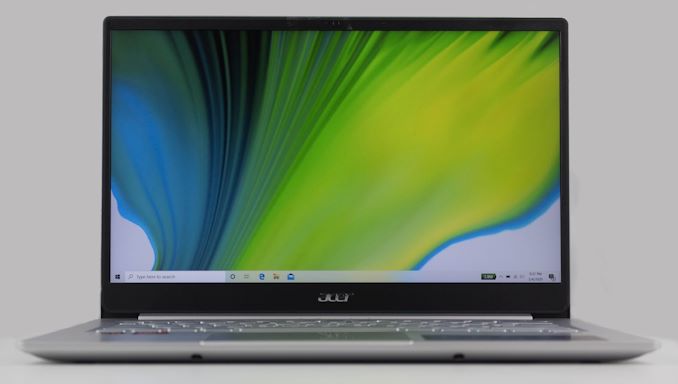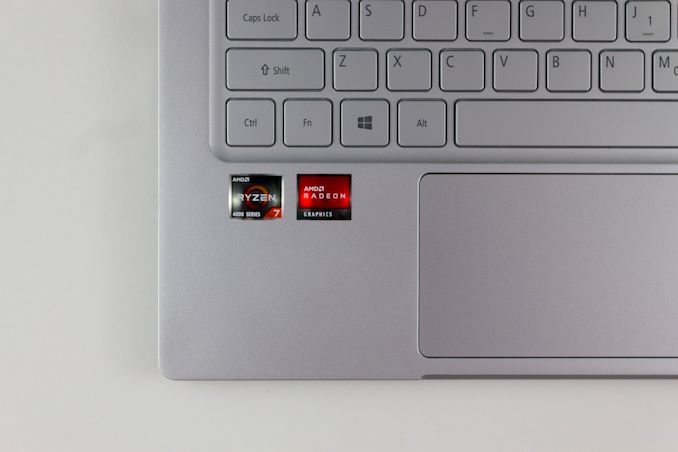The Acer Swift 3 SF314 Notebook Review: Swift Gets Swifter With Ryzen 4000
by Brett Howse & Andrei Frumusanu on May 5, 2020 8:00 AM EST
Almost two years ago to the day, we had a chance to check out Acer’s Swift 3 laptop featuring AMD's first Ryzen Mobile platform, Raven Ridge. Acer has been a strong partner for AMD, generally being one of the first out of the gate with new designs featuring AMD’s latest platforms, and this year that partnership has played out again. Today we are taking a look at the newest AMD APU offering, the Ryzen 4000 "Renoir", which is at the heart of Acer’s latest iteration of the 14-inch Swift 3. With a brand-new AMD processor and some innovations in the Swift 3 design itself, both AMD and Acer have made some tremendous improvements for 2020.
Ryzen 7 4700U
The big news for 2020 is AMD’s new APU platform, codenamed Renoir. Selling as the Ryzen 4000 series, these new APUs bring a number of major updates to AMD's platform, as the company further sands down the rough edges from the Ryzen 3000 Picasso series. Key to this is a much-needed jump from GlobalFoundries' 12nm process to TSMC's class-leading 7nm process, giving AMD a much-wanted boost in transistor performance and overall energy efficiency. Coupled with a number of further optimizations at the chip and driver level, and AMD's latest APUs are proving far better suited for thin-and-light mobile designs than their predecessors.
Under the hood, like AMD's desktop processors introduced last year, the new Ryzen 4000 series APUs are the first laptop-focused products from AMD which feature their Zen 2 CPU cores. Designed hand-in-hand with TSMC's 7nm process, the Zen 2 architecture has further boosted AMD's performance across both IPC and clockspeeds, and the small cores have allowed AMD to get away with 8 of them in even a laptop APU. Meanwhile the iGPU is based on the same Vega architecture graphics as both the 2000-series and 3000-series APUs, but in a new configuration. Thanks to TSMC’s 7nm process, AMD has been able to crank up the GPU frequency much higher than before – so much higher that they’ve actually scaled back on the number of GPU compute units, while still promising improved GPU performance over the previous generation of APUs.
Ian had a chance to take the new Ryzen 4000 platform for a spin in early April, although that sample was the 45-Watt H series. Many of the concepts carry across though, so if you’ve not yet had a chance to catch up on Renoir, be sure to check out the Ryzen 9 4900HS review. The 45-Watt processor range is pretty much the standard in high-performance notebooks, but the vast majority of laptops on the market stick to the lower-powered 15-Watt range, which is what we have in the Acer Swift 3.
Acer has opted for what is likely to be one of the most popular SKUs in the AMD Ryzen 4000 range, the Ryzen 7 4700U. AMD has gone a very non-traditional route for this part, offering eight physical CPU cores, but disabling simultaneous multithreading (SMT). All of AMD’s H-Series lineup of 45-Watt processors do offer SMT, but only two of the new U-Series provide this, with the Ryzen 5 4600U offering 6 cores and 12 threads, and the Ryzen 7 4800U providing 8 cores and 16 threads, all in the 15-Watt thermal design power (TDP) that is so common on laptops. In the typical 15-Watt laptop space, AMD is the first to offer 8 cores, just not always with SMT.
On the GPU side, the Ryzen 7 4700U offers 7 Vega-architecture Compute Units (CUs), with a maximum clockspeed of 1600 MHz. Compared to the previous generation Ryzen 7 3700U, the GPU drops three compute units, but bumps the maximum frequency from 1300 MHz to 1600 MHz, so we shall see where this plays out in terms of performance.
The Acer Swift 3
Acer has managed to bundle a lot of product into the Swift 3. The 14-inch notebook features a 1920x1080 IPS display that, albeit lacking touch support, does get showcased well thanks to the Swift 3's thin bezel surround. The laptop ships with 8 GB of DDR4-3200, and though we would have loved to see LPDDR4X, the capacity is what is important here, and 8 GB is a good amount for a budget-friendly laptop like the Swift 3. Also, Acer has managed to outfit this notebook with a 512 GB SSD, which is fantastic. They will also be offering a less-expensive version with a Ryzen 5 4500U, 8 GB of RAM, and a 256 GB SSD.
| Acer Swift 3 SF314-42 | |||||
| Ryzen 5 | Ryzen 7 Model Reviewed |
||||
| CPU | AMD Ryzen 5 4500U 6 core 6 thread 2.3-4.0 GHz 2x 4MB L3 15W TDP |
AMD Ryzen 7 4700U 8 core 8 thread 2.0-4.1 GHz 2x 4MB L3 15W TDP |
|||
| GPU | AMD Vega 6 6 CUs 1500MHz Boost |
AMD Vega 7 7 CUs 1600MHz Boost |
|||
| RAM | 8 GB Dual-Channel DDR4-3200 | ||||
| Storage | 256 GB PCIe NVMe SSD | 512 GB PCIe NVMe SSD | |||
| Display | 14-inch 1920x1080 IPS | ||||
| Networking | Intel Wi-Fi 6 AX200 2x2:2 802.11ax Bluetooth 5.0 |
||||
| Audio | Stereo Speakers DTS Sound |
||||
| Battery | 48 Wh Li-Ion 65-Watt Charger (barrel connector) USB Power Delivery Support |
||||
| Right Side | USB 2.0 x 1 Headset jack Battery Charge Indicator |
||||
| Left Side | USB 3.2 Gen 1 x 1 with power-off charging USB 3.2 Gen 2 Type-C w/DisplayPort, PD HDMI 2.0 Charging connector |
||||
| Dimensions | 323.4 x 218.9 x 15.95 mm 12.73 x 8.62 x 0.63 inches |
||||
| Weight | 1.2 kg / 2.65 lbs | ||||
| Camera | 720p Super High Dynamic Range | ||||
| Extras | Fingerprint Reader | ||||
| Price (MSRP) | $629 USD | $649 USD | |||
Despite the strong APU, RAM, and storage offerings, Acer is not done there. The Swift 3 also features Wi-Fi 6 thanks to Intel’s AX200 wireless adapter, which means 2.4/5.0 GHz wireless support with 160 Mhz channels if your router is has the correct capabilities. There’s also an integrated fingerprint reader for Windows Hello Support, and the entire package is contained in an all-aluminum chassis which weighs just 1.2 kg / 2.65 lbs. Considering the $649 MSRP, this is an incredible value.











191 Comments
View All Comments
12345 - Tuesday, May 5, 2020 - link
The dell xps has half the cores and a slightly bigger battery...notb - Wednesday, May 6, 2020 - link
There's a "normalized" comparison with battery capacity impact removed.Don't look at the number of cores. It doesn't matter.
Look at performance:
https://www.anandtech.com/show/15762/the-acer-swif...
Ryzen is faster, but not twice as fast.
Spunjji - Wednesday, May 6, 2020 - link
These aren't relevant to the "normalized" scores. What is relevant is: smaller screen, lower-power screen, platform design optimised over several generations, and that the device costs nearly 3 times as much. You can do a lot more selective component sourcing and rigorous platform optimization for that price difference.Spunjji - Wednesday, May 6, 2020 - link
1) Competing doesn't mean winning, and an improvement that gets AMD to the point of working-day battery life from an inexpensive device is a significant one. It's definitely competing.2) Based on the results in other areas (like sustained frequency) I'm inclined to believe this isn't a particularly well-optimised example of the platform - meanwhile, the Intel hardware it's up against has been well-characterised by the OEMs at this stage. It doesn't matter to a consumer or a buyer of this specific device, but it does affect overall comparisons. The numbers from the Zephyrus G14 are much more positive (although it does use a better bin of the chip).
warisz00r - Tuesday, May 5, 2020 - link
I'd be more than happy to pay $300 - $400 more if it comes with 1) bigger battery 2) double the RAM 3) better display and 4) better cooling but $649 is still a really good deal for those who prioritizes CPU performance.neblogai - Tuesday, May 5, 2020 - link
Check the Lenovo Slim 7. It is a bit more expensive to start with, and weighs 1.4kg, but comes with 100% sRGB Freesync IPS 300Nits+ display, bigger battery, has option for 16GB of RAM (LPDDR4X 4266), and much higher power profiles that allow sustained ~28W APU power.psychobriggsy - Tuesday, May 5, 2020 - link
That looks really nice! And Freesync on an APU powered laptop makes sense as frame rates can dip.ads295 - Tuesday, May 5, 2020 - link
I think Acer look to appeal to a certain class of people that don't want to pay too much for a decent PC and don't really know a lot about them either - I guess that's your typical consumer who doesn't read AnandTech. So all these additions would undoubtedly add value to the notebook but whether the increase in perceived value is enough to justify an increase in price is a matter of risk.Evidently they think it's better to stick to a formula (compact form, good APU, plenty of RAM and SSD storage with decent battery life) to make it a no-brainer of sorts at that price point.
psychobriggsy - Tuesday, May 5, 2020 - link
The price is outstanding for an 8C performance-leading laptop.But yes, if Acer could do a version of this but: (1) 16GB LPDDR4X on board (2) Upgrade the screen quality (or at least offer a screen upgrade or two at online purchase time) (3) better battery option (if space allows).
The screen is the real let down in this device however - which is a shame considering the performance.
Oxford Guy - Thursday, May 7, 2020 - link
Oh, yeah... Throttling the CPU to 8 watts is a recipe for being "performance-leading".